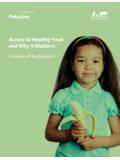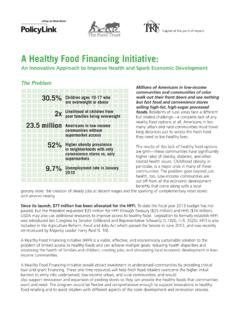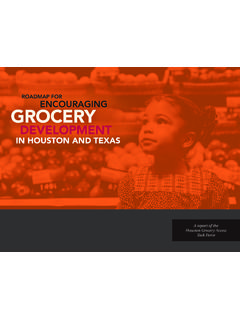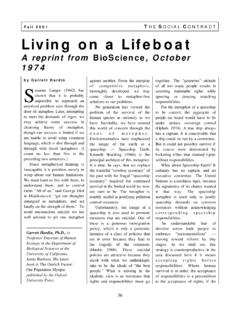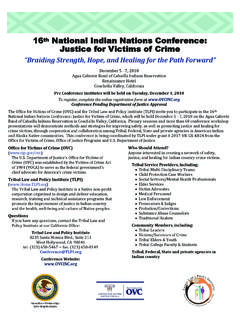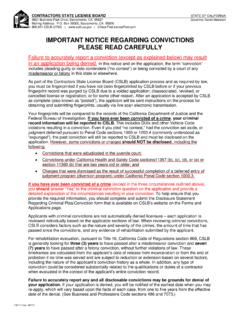Transcription of Headquarters - The Food Trust | Home
1 PolicyLink is a national research and action institute advancing economic and social equity by Lifting Up What Works . The Food Trust , founded in 1992, is a nonprofit organization working to ensure that everyone has access to affordable, nutritious food. Design by: Leslie Yang COVER PHOTOS COURTESY OF (from left to right, top to bottom): Zejica; Lorie Slater; image100 Photography;. Richard Beebe. PHOTOS COURTESY OF: : David Gomez Photography; : Lorie Slater; : Victor Melniciuc; : Bart Sadowski; : Plush Studios/Blend. PolicyLink The Food Trust Sarah Treuhaft PolicyLink Allison Karpyn The Food Trust PolicyLink The Food Trust Acknowledgments PolicyLink and The Food Trust are grateful to the funders who supported the development and publication of this report, including the Convergence Partnership and the Kresge Foundation.
2 The research for this study was conducted with indispensable assistance from Diana Fischmann (former intern, The Food Trust ), who initially collected, reviewed, and summarized many of the studies, and Allison Hagey (PolicyLink). who adeptly assisted with the data analysis and manuscript development. Many thanks to Jennefer Keller, Jon Jeter, and Leslie Yang (PolicyLink), and Lance Loethen (The Reinvestment Fund) for their assistance. Our gratitude also extends to Judith Bell and Rebecca Flournoy (PolicyLink), John Weidman (The Food Trust ), and Ira Goldstein (The Reinvestment Fund) who provided helpful guidance and feedback throughout the research process. 2. PolicyLink The Food Trust Contents 5 Preface 7 Executive Summary 11 Introduction 13 Findings 21 Implications for Policy 23 Methods 25 References 32 Notes 3.
3 PolicyLink The Food Trust Improving access to healthy food is a critical component of an agenda to build an equitable and sustainable food system. 4. PolicyLink The Food Trust Preface For decades, low-income communities of color have Centers for Disease Control and Prevention, adult suffered as grocery stores and fresh, affordable obesity rates are 51 percent higher for African food disappeared from their neighborhoods. Americans than whites, and 21 percent higher Advocates have long drawn attention to this critical for Latinos. Black and Latino children are more issue and crafted policy solutions, but access to likely to become obese than white children. The healthy food is just now entering the national policy lack of healthy food retail also hinders community debate.
4 While the problem is obvious to impacted economic development in neighborhoods that communities, good policy must also be based on need private investment, activity hubs, and jobs. solid data about the issue and its consequences. Thankfully, the tide is beginning to turn. Researchers Unfortunately, it often takes years for the research and policymakers are coming to consensus that to catch up with pressing needs in historically this is a critical issue. And they are recognizing that underserved communities. Sometimes information is communities have developed innovative, sustainable not available. Other times, evidence is accumulating solutions that can work in other locales and at larger but it is buried in journals not widely read by scales.
5 In December 2009, 39 members of Congress policymakers. Or it is produced by practitioners and from both political parties issued a resolution in the advocates for local action campaigns and not accepted House of Representatives recognizing the need for by researchers or shared with policymakers or the national policy to address limited access to healthy broader field. Too often, research focusing on low- food in underserved communities. The President's income people and communities of color, informed 2011 budget calls for more than $400 million to by their experiences, or conducted in partnership establish a national Healthy Food Financing Initiative, with them, is perceived as a political strategy, and this initiative is a key component of the First rather than as a legitimate search to understand Lady's Let's Move campaign to reduce childhood problems and inform strategies for change.
6 Obesity. Legislation to create a Healthy Food Financing Initiative is expected to be introduced in PolicyLink and The Food Trust conducted this both the House and the Senate in Spring 2010. inquiry to summarize the existing evidence base, carefully reviewing more than 132 studies. We This report presents powerful data. It confirms found that a large and consistent body of evidence that as a nation we must answer the appeals of supports what residents have long observed: many community activists seeking access to healthy food low-income communities, communities of color, for their families and their neighborhoods. We and sparsely populated rural areas do not have hope that it provides policymakers, advocates, sufficient opportunities to buy healthy, affordable philanthropists, and others with information, food.
7 The consequences are also clear: decreased evidence, and analysis that can inform their efforts access to healthy food means people in low-income to eliminate food deserts from neighborhoods communities suffer more from diet-related diseases and communities across the country. like obesity and diabetes than those in higher- income neighborhoods with easy access to healthy food, particularly fresh fruits and vegetables. Inequitable access to healthy food is a major Angela Glover Blackwell Yael Lehmann contributor to health disparities. According to the Founder and CEO Executive Director PolicyLink The Food Trust 5. PolicyLink The Food Trust In hundreds of neighborhoods across the country, nutritious, affordable, and high quality food is out of reach.
8 Particularly low-income neighborhoods, communities of color, and rural areas. 6. PolicyLink The Food Trust Executive Summary An apple a day? the past 20 years. This bibliography incorporates a total of 132 studies: Sixty-one published in peer- F or millions of Americans especially people reviewed journals and primarily conducted by living in low-income communities of color university-based researchers and 71 conducted finding a fresh apple is not so easy. Full-service by practitioners or policy researchers, sometimes grocery stores, farmers' markets, and other vendors in collaboration with academic researchers, and that sell fresh fruits, vegetables, and other healthy self-published (also known as grey literature ).
9 Foods cannot be found in their neighborhoods. The studies include three nationwide analyses What can be found, often in great abundance, of food store availability and neighborhood, are convenience stores and fast food restaurants city, county, regional, statewide, and multistate that mainly sell cheap, high-fat, high-sugar, analyses covering 22 states across the country. processed foods and offer few healthy options. Without access to healthy foods, a nutritious Findings diet and good health are out of reach. And without grocery stores and other fresh 1. Accessing healthy food is a challenge food retailers, communities are missing the for many Americans particularly those commercial hubs that make neighborhoods livable, and help local economies thrive.
10 Living in low-income neighborhoods, communities of color, and rural areas. In For decades, community activists have organized hundreds of neighborhoods across the country, around the lack of access to healthy foods as nutritious, affordable, and high quality food an economic, health, and social justice issue. As is largely missing. Studies that measure food concerns grow over healthcare and the country's store availability and availability of healthy foods worsening obesity epidemic, food deserts areas in nearby stores find major disparities in food where there is little or no access to healthy and access by race and income and for low-density, affordable food have catapulted to the forefront rural areas.
